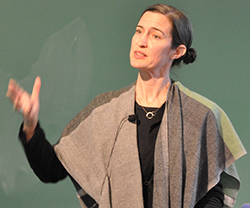Jen Bervin Discusses Mixing Poetry with Technology
Bervin’s visit was a part of Northwestern Engineering’s Dean Seminar Series on February 13
Jen Bervin’s experimental work Silk Poems started with a question. If she had a silk biosensor embedded beneath her skin, what would she want it to say?
 Exploring the answer led Bervin on a five-year journey through more than 30 international nanotechnology and biomedical labors, textile archives, medical libraries, and sericulture sites in North America, Europe, the Middle East, and Asia. The final work, which includes a poem nanoprinted on silk and viewed under a microscope, a video, and the poem’s entire manuscript, debuted in May 2016 at the Massachusetts Museum of Contemporary Art.
Exploring the answer led Bervin on a five-year journey through more than 30 international nanotechnology and biomedical labors, textile archives, medical libraries, and sericulture sites in North America, Europe, the Middle East, and Asia. The final work, which includes a poem nanoprinted on silk and viewed under a microscope, a video, and the poem’s entire manuscript, debuted in May 2016 at the Massachusetts Museum of Contemporary Art.
As a part of the Northwestern Engineering’s Dean Seminar Series, artist and poet Bervin discussed Silk Poems and her other boundary-blurring projects. Co-sponsored by the Block Museum of Art, the seminar took place Monday, February 13 in the Ford Motor Company Engineering Design Center.
Bervin first learned about silk biosensors while watching a talk by Tufts University’s Fiorenzo Omenetto. A bioengineer, Omenetto and his team are building implantable, silk biosensors that could monitor patients’ vitals after surgery or track chronic illnesses. The concept of an ancient material used for high-tech functions inspired Bervin. She also thought about the patients, who might benefit from an enpowering message written on the sensor.
“There could be more to the sensor than just the sensing,” she said. “It would not merely be functioning in the sensing capacity but in the imagination.”
In conjunction with Tufts University’s Silk Lab, Bervin nanoprinted a poem onto a liquid silk biosensor that could be placed inside the body. The booklength poem, written from the perspective of a silkworm, embodies silk’s rich history as well as cutting-edge medical technologies. The poem’s structure weaves back and forth in figure eights — mimicking the snakelike pattern of DNA and the way a silkworm rhythmically moves when it builds a cocoon.
During the seminar, Bervin shared a video about the inspiration and process behind Silk Poems and read two excerpts from the final poem.
Silk Poems is just one of Bervin’s projects, in which she mixes science, poetry, and textiles. “The word ‘text’ comes from ‘textile,’ and I often work at the boundary of the two,” she said.
Bervin’s other projects include:
- River, a large-scale model of the Mississippi River made of hand-sewn sequins
- Su Hui’s Reversible Poem, a double-sided silk embroidery of the poem Xuanji Tu
- The Dickinson Composites, a series of large-scale embroideries that depict poet Emily Dickinson’s variant marks in her manuscripts